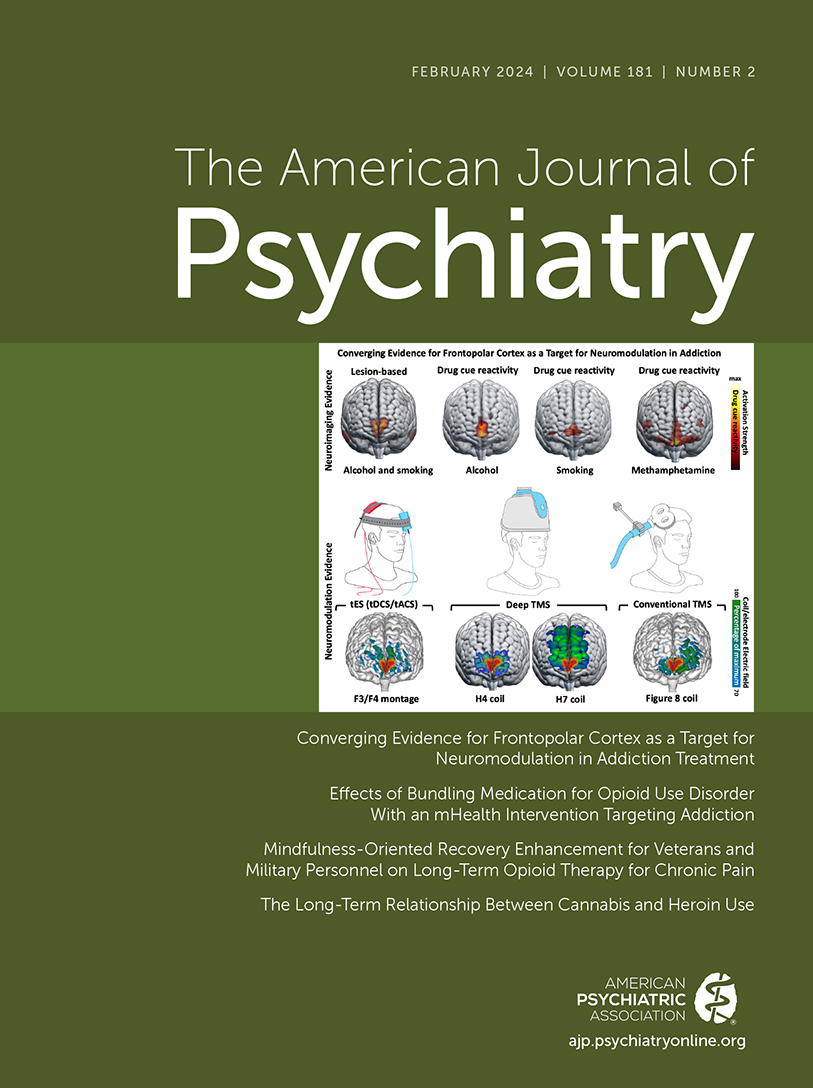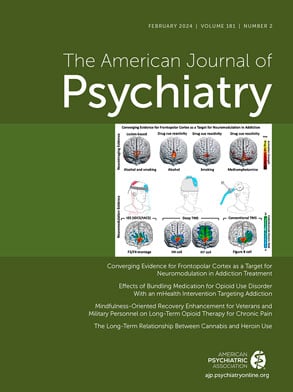Cannabis is now legal for recreational and/or medical use in most U.S. states. Decriminalizing cannabis use and possession is important for eliminating decades-old racist policies but is occurring alongside increasing consumption, particularly of more potent products (e.g., vape liquids, concentrates). In the United States, 52.5 million people aged 12 and over used cannabis in the past year, and every 12 seconds, someone uses cannabis for the first time (
1).
Most people who use cannabis do not develop problems and, indeed, there can be both subjective and medical benefits of use (
2), although perceived medical benefits are often unsubstantiated by evidence. However, there is a growing subgroup experiencing harms. Approximately 22% of those who use cannabis develop a cannabis use disorder, characterized by persistent use despite clinically significant impairment (e.g., failure to fulfill roles) and/or distress (
3). Potential negative consequences of excessive cannabis use include physical (e.g., cannabis hyperemesis, respiratory problems), mental (e.g., worsening anxiety, psychosis, cognitive impairments) and social impacts (e.g., academic and family problems), yet treatment rates (∼5%) for cannabis use disorder are exceedingly low (
4).
Cannabis has high public support; most Americans favor some form of legalization and many view cannabis as a benign substance. This social acceptability is accompanied by beliefs that cannabis provides many unproven benefits. Indications for obtaining medical cannabis include conditions with evidential support (e.g., chemotherapy-induced nausea/vomiting) and conditions with minimal or no evidence (e.g., Parkinson disease, mental health conditions [
2]). This climate makes it challenging for individuals and clinicians to recognize and discuss cannabis-related harms and treatment needs. For example, irritability, anxiety, and sleep problems may not be readily identified as symptoms of cannabis withdrawal, leading patients to resume cannabis to reduce these symptoms. Further, some people may forego effective treatments and use cannabis to self-treat mental health symptoms, some of which may be exacerbated by cannabis. Thus, to reduce harms among those who have developed cannabis use disorder, clinicians must use patient-centered approaches, focused on accurate discussion of the relative benefits and harms for the individual.
Central to harm reduction, which arose from 1980s grassroots movements, is the notion that, instead of abstinence-only approaches, we can also focus on reducing high-risk behaviors associated with negative outcomes in order to improve population health and better engage people who use substances (
5). Harm reduction is promising in addressing the opioid epidemic (e.g., syringe services), with applications to other substances (e.g., tobacco with varying delivery modalities and levels of nicotine and tar [
6]). We posit that the ethos of harm reduction—to minimize harms associated with substance use, via reduction of use and/or harms from use—has applications to cannabis use disorder. Given the minimal research to date on harm reduction for cannabis, there is much work to be done and we emphasize the importance of evaluating this approach on an array of outcomes.
To this end, we need to articulate, define, and study harm reduction approaches that are patient-centered and aligned with the priorities of people living with cannabis use disorder. To do so, we need to: 1) establish if specific levels of cannabis consumption are associated with risk-reduction and improved outcomes; 2) consider preferences for and risks of varied types of cannabis use (e.g., modality, potency); and 3) tailor recommendations for special populations (e.g., those at risk for psychosis, pregnant, adolescents/young adults).
Evaluate and Establish Risk Levels
First, clinicians and researchers have historically prioritized abstinence outcomes (e.g., substance-free days) as key treatment targets, likely given that abstinence may be considered the most risk-free goal. Recently, however, leaders in the alcohol field have adopted a new, patient-informed definition of recovery, defined as a process marked by cessation of
heavy drinking and remission from alcohol use disorder (e.g., no symptoms other than craving [
7]). Similarly, the World Health Organization has defined risk levels for drinking (e.g., low, medium, high, based on quantity) and 1-to-2 level reductions portend reduced consequences and better mental health (
8). It is possible that similar guidance could be offered to reduce cannabis-related consequences, but we need to gather more data to inform definitions of cannabis consumption risk levels and whether corresponding changes in risk predict functional improvements.
Consider Preferences for and Risks of Different Cannabis Products
Second, in determining potential thresholds for lowering risk, researchers must evaluate the biomedical and psychosocial risks associated with the range of cannabis products (e.g., concentrates, vape liquids, flower, edibles). Defining risk-reduction levels for cannabis is complicated now by cannabis products that may have distinct patterns of use (e.g., people may vape more frequently than use edibles) and vary widely in duration of effects and potency. For example, we currently cannot compare the impacts of dabbing a high-potency wax versus consuming a single 10mg gummy once a day, although these products intuitively suggest differential risk profiles despite having similar urine toxicology results. Experts also recommend development of more precise tools to adequately measure frequency and quantity of cannabis use across different products (
9). Given the challenges of comparing across products and potencies, we need new studies that focus on outcomes beyond consumption and instead on broad impacts, including on mental and physical health, quality of life, and functioning. Future studies following cohorts of people who use different cannabis products can help examine changes in relevant outcomes over time and trajectories of cannabis use patterns to elucidate a full picture of recovery.
Consider Risk-Reduction in Special Populations
Lastly, in considering harm reduction for cannabis, we must attend to populations that experience heightened risks. Cannabis use among adolescents and young adults could negatively impact neuromaturation and be associated with long-term impairments in cognitive functions (
2). Cannabis use is also associated with a lower threshold for onset of psychosis among those predisposed and can exacerbate symptoms (
2). As part of harm reduction strategies, actionable policy-level interventions (e.g., large-print warning labels, THC potency caps) may be considered in the legal cannabis market to mitigate risks of negative consequences. Finally, cannabis use in pregnancy is associated with short- and long-term risks for fetal development and some children’s outcomes (
2). Concerns about cannabis use in pregnancy have led to removing newborns from mothers who use cannabis. Although cannabis use is not ideal in pregnancy, removing newborns may cause more irreparable harm. And this is the crux—even among populations who face higher risk for negative outcomes from cannabis use, treatment rates remain abysmally low. Thus, we need to prioritize approaches to engage all people in reducing risks of their consumption and on goals they care about, as opposed to narrowly focusing on abstinence only.
In sum, decriminalizing cannabis is an important first step in addressing harms, but we must also address the realities of problematic use and cannabis use disorder. Public health concerns regarding cannabis use have been rightly overshadowed by the need to dismantle racial injustices, along with movements focused on individual liberties and potential medicinal benefits. These issues have muddied the waters of both research and good clinical care, which should involve patient-centered conversations about the relative benefits and drawbacks of cannabis use for the individual. To this end, as a field, we must define new harm reduction approaches and potential risk levels for cannabis use, supported by empirical evidence, as a key step toward closing the cannabis use disorder treatment gap.

